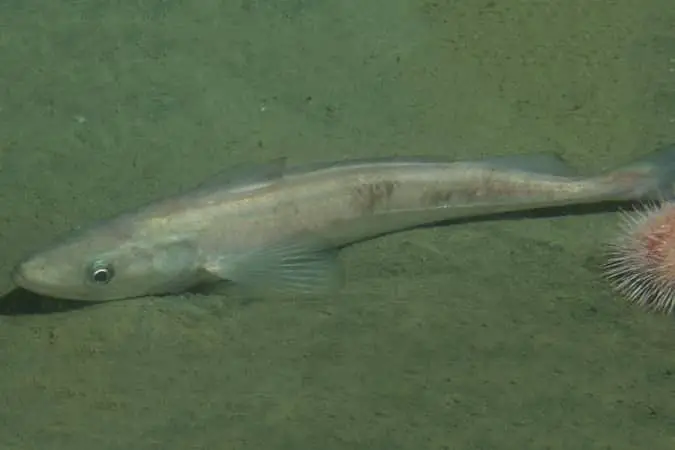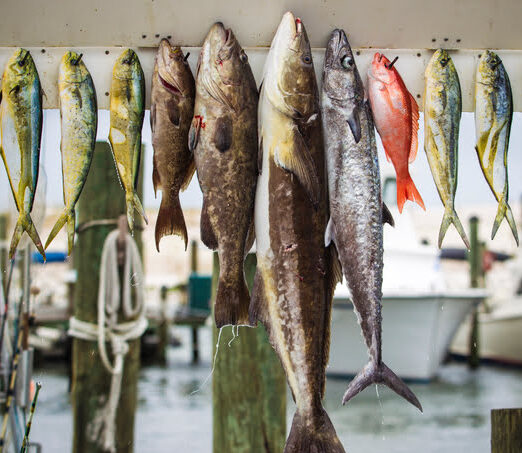These two terms have been the topic of discussion in many fishing forums because of the striking similarities of the fish species they describe and their shared environment.
Anglers use the names in reference to certain saltwater fish that spend most of their adult life at the bottom of the sea, whose sizes and body structures are almost similar.
We are here to find out the difference between mullet vs whiting, why the confusion, and how do we discern one from another?
Let’s dive in!
Table of Contents
- What’s the Difference Between Whiting and Mullet?
- Why The Confusion?
- Types Of Mullet
- Types Of Whiting
- Are Sea Mullet and Whiting the Same?
What’s the Difference Between Whiting and Mullet?
Although mullet and whiting look somewhat similar and share the same coastal habitats, they are referring to two different species of fish. Mullet are a schooling fish, that feed on detritus in salt and brackish environments. Whiting are members of the drum family and feed on shrimp, sand fleas and crabs along shallow coastlines.
What About Taste?
While whiting has a mild flavor, mullet is considered strong by many, making it an acquired taste for many.
Although in the coastal gulf states of Florida, Louisiana, Alabama, Mississippi and Texas smoked mullet or fried mullet roe is a delicacy! Just ask my Dad!

However, most anglers use mullet as live bait or cut bait to catch game fish such as sharks, snook, redfish…and even catfish!
Whiting is fished primarily for its culinary value, although the heads can also be used as bait. They are frequently caught by surf anglers.
Why The Confusion?
In certain areas of the world, colloquial terms and nicknames are developed by anglers.
For example, Southern Kingfish, also known as ‘whiting’ are often called “Sea Mullet” or “Virginia Mullet” by residents of North Carolina and Virginia.
Additionally, there is another sub-species of Whiting in europe that is from the Gadidae family comprises cods and haddocks, where Gadiformes are cods.
They form the basis on which other fish species are classified as whiting.
Types Of Mullet
Mullet are a class of small fish to medium-sized marine fish and are part of the Mullidae family. They can be identified by their two separate dorsal fins and sensory barbels that double as foraging tools when looking for food on the seabed.
The flathead grey mullet (also known as the striped mullet) has six to seven horizontal stripes and is olive green at the back, which gradually pales on the sides to silver then to white on the underbelly.
Being the largest mullet, it can get as heavy as 18 pounds. The typical adult length is 20-inches. The smaller white mullet grows to an average of 12-inches and is mostly used as a bait.
The red mullet has a unique bright red skin while its striped, red relative has red stripes. They are not closely related to the grey mullet but belong to the Mullus genus of the Mullidae family.
Types Of Whiting
The term whiting is more popular than its scientific name. It is used in reference to several fish species with certain similar features (hence, the confusion among anglers).
The original whiting is the merling, or as you most likely know it, the English whiting. The species’ scientific name is merlangius merlangus.
The Food and Agriculture Organization of the United Nations (FAO) places them in the Gadiformes order of the Gadidae family of marine fishes in their International Standard Statistical Classification for Aquatic Animals and Plants (ISSCAAP).
The ray-finned fishes exist naturally in brackish water and are predominantly bottom dwellers.
They thrive in mud and gravel bottoms and sometimes sand and rock. They have elongated bodies featuring three dorsal fins and two anal fins.
They come in various colors, greenish to yellowish-brown, with whitish flanks and silvery bellies. These attributes are shared with several species that fisheries refer to as whitefish.
Whiting includes other Gadiformes like hakes, specifically the merluccius genus like the European hake, silver hake (Atlantic whiting), and North Pacific hake (Pacific whiting).

Other species in the Gadus genus like the Alaskan Pollock and the Southern blue whiting also make the list.
Some species are not as closely related but are still referred to as whiting due to shared characteristics like the smelt whiting.
The difference is not very discernible, but some like the sand or summer whiting and the King George whiting have two separate dorsal fins instead of three.
We also have the croakers, which we will get to in a bit (confused yet?)
Besides the cod-like long tapering body, the affinity to brackish water, and inshore bottom-feeding, the other quality whiting has in common with mullet is they make excellent table fish.
They provide flaky white flesh with mild flavors and are a seafood favorite.

Do You Love Seafood?
Are Sea Mullet and Whiting the Same?
This particular species requires special mention in this forum because it is referred to as both mullet and whiting and is arguably the cause of the mullet vs whiting confusion.
Sea mullet, also known as Southern king croakers or the Southern kingfish, belong to the Menticirrhus genus of the Sciaenidae family. They are commonly referred to as drums or croakers because of their sounds to attract mates during spawning season.
They have unique sonic muscles on their body walls with which they drum their swim bladders to make the sound. These muscles expand for the breeding season and revert to their regular size afterward.

Other croakers include the Northern king croaker (Northern kingfish), California corbina (Californian king croaker), the yellowfin croaker (surf fish), and the gulf kingfish (also known as the kingcroaker or gulf whiting).
These croakers have different hues of silvery grey and copper or bronze sheen with pale underbellies associated with white fish.
Their bodies are long and slender, and they typically grow to between 10 and 14 inches. These kingfish exist in schools and are largely demersal. They thrive in coastal waters with muddy bottoms. They are excellent table fish to find when surf fishing.
They provide white and lean flesh with a mild flavor.
Because they fit the bill, all these drum species are also referred to as whiting. The naming confusion is because sea mullet are scientifically not a mullet species.
Their inclusion as whiting can easily be misconstrued to imply that mullet are whiting. This is aggravated by the existing similarities between whiting and mullet.
Sea mullet are whiting, but whiting represents a lot more than sea mullet. It is a term used to refer to fish species sharing the qualities we have explored.

Growing up in Florida, I’ve been surrounded by saltwater my entire life…and I love sharing my passion with others.
To learn more about why I started Saltwater Mecca, visit the ABOUT page.
Thank you for reading this article. Browse around & have some fun!